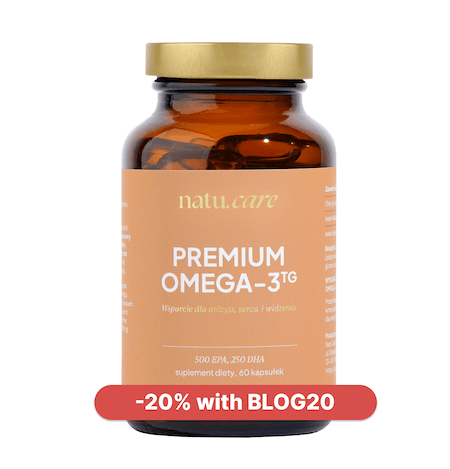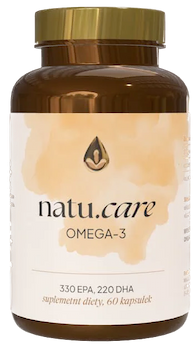- Home
- Omega acids
- Triglycerides of omega-3 fatty acids
Triglycerides of omega-3 fatty acids - why are they better than esters?
When choosing a dietary supplement with omega-3 fatty acids, pay attention to whether it is the triglyceride form.


Learn more about our editorial process
.

Learn more about our editorial process
.

Learn more about our editorial process
.

Learn more about our editorial process
.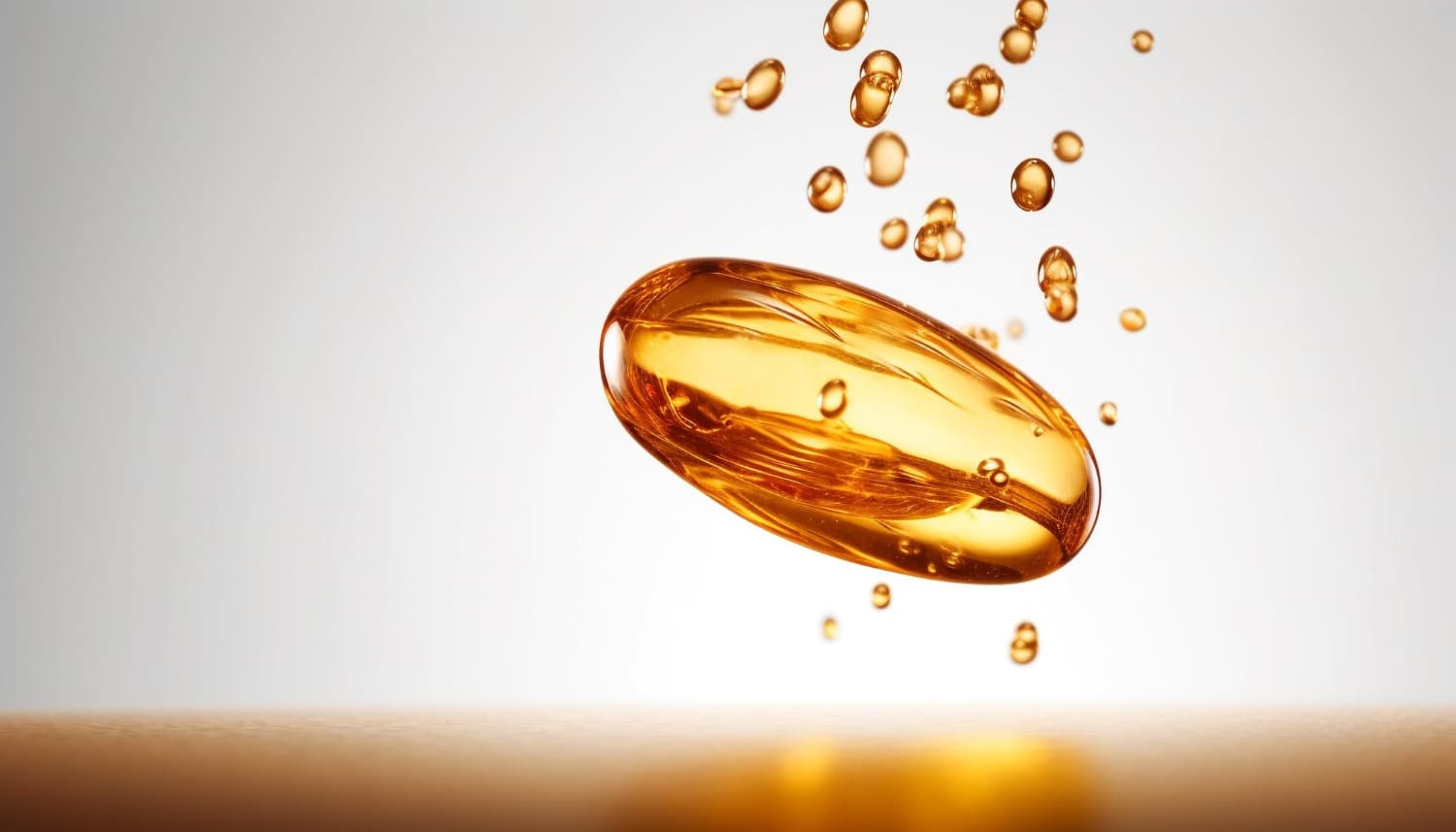
Why you can trust us
Articles on Natu.Care are written based on scientific research, data from government websites and other reliable sources. The texts are written in cooperation with doctors, nutritionists and other health and beauty experts. Articles are reviewed before publication and during significant updates.
.Learn more about our editorial process
.Information about advertisements
Content on Natu.Care may contain links to products from the sale of which we may receive a commission. When creating content, we adhere to high editorial standards and take care to be objective about the products discussed. The presence of affiliate links is not dictated by our partners, and we select the products we review ourselves completely independently.
.Learn more about our terms and Conditions
.If you choose collagen, it's fish collagen, if magnesium it's lactate, and if omega-3 fatty acids it's... Well, precisely in which form to choose healthy fats so that they are well absorbed and make up for their deficiency in your diet?
Together with Ilona Krzak, MSc in pharmacy, and clinical nutritionist Julia Skrajda, we have taken the triglycerides of omega-3 fatty acids, i.e. their natural form, which for good reason... you rarely find in dietary supplements. But something feels like it will still make its way onto your shelf.
From this article you will learn:
- What are the triglycerides of omega-3 fatty acids.
- What are the triglycerides of omega-3 fatty acids?
- What is the difference between triglycerides and ethyl esters.
- Why you should choose supplements with omega-3 in the form of triglycerides.
- What the scientific findings suggest.

Sprawdź, za co pokochały go tysiące klientek Natu.Care Premium Omega-3ᵀᴳ -15% z kodem BLOG15
Natu.Care Omega-3ᵀᴳ Premium
Natu.Care Omega-3ᵀᴳ Premium dla zdrowia serca, mózgu i odporności. Najlepsza przyswajalność. Optymalna dawka 750 mg. Przebadana przez niezależne laboratorium.
Zobacz więcej
Produkt ma super skład, transparentną etykietę i co dla mnie jest ważne – małe kapsułki do połknięcia. Nie ma też nieprzyjemnego efektu odbijania rybą, który miałam spożywając inne produkty. Widzę znaczną poprawę odporności. Polecam!@Kasia P.
See also:
- Omega-3 fatty acids - which ones to choose?
- Omega-3 fatty acid deficiency - symptoms
- Omega-3 fatty acids
- Omega-6 fatty acids
- Omega-9 fatty acids
- Omega 3-6-9 acids
- DHA acid
- EPA acid
- ALA acid
Dietary omega-3 fatty acids
Do you enjoy eating oily fish? I do. I certainly inflate the stats and throw in quite a few kilos of salmon.
I'm not sure I do.
Unfortunately, Poles eat too little oily fish. According to FAO data, a Pole eats 12.27 kg of fish per year, while a Portuguese eats.... 59.36 kgand. We don't have such a fish-eating culture in our country, their prices are a deterrent, and vege diets are gaining more and more followers.
Effect: no fish in the diet, no DHA and EPA, instead there is an omega-3 deficiency. The body cannot function properly without themand.
If you're not eating 1-2 portions of oily fish weekly (because, for example, I've bought out the whole lot), you should probably be supplementing with omega-3 fatty acids. And even if you're eating plenty of healthy fats in the form of fruit or nuts - you're only supplying yourself with alpha-lipoic acid (ALA).
Fish such as salmon, mackerel and sardines are the richest in DHA and EPA acids.

Ilona Krzak Master of Pharmacy
That's why if fish isn't your thing, consider omega-3 fatty acid supplementation. And since you're buying a dietary supplement, choose one that will assimilate effectively into your body and work.
But... what does that actually mean?
What gets assimilated well?
The supply of nutrients to the body depends not only on the amount of a substance in the food, but also on its bioavailability and assimilability.
availability refers to the body's ability to absorb and utilise nutrients from food, while bioavailability is the degree to which a nutrient can be absorbed and transported into the bloodstreamand.
When we say that a substance is 'well absorbed', it means that the ingredient has a high bioavailability, it is absorbed into the body more efficiently and in greater amounts, and the body benefits better from its properties.

Ilona Krzak Master of Pharmacy
Your body's bioavailability is variable and depends on many factors, such asand:
- state of health,
- metabolism of the substance after absorption,
- physico-chemical properties (form of chemical bond),
- the presence or absence of other food components that enhance or inhibit absorption,
- other individual factors (e.g. diseases).
The same is true for pharmaceuticals -their efficacy depends on the bioavailability of the active substances they contain. If you want to supplement nutrients from dietary supplements, you need to put aside the marketing of the preparation in question and pay attention to bioavailability.
Many dietary supplements have a "well-known" brand name or are ubiquitous in advertising, yet when you read their composition, you find, for example, that you will not make up for a magnesium deficiency because it is in the form of oxide with a bioavailability of ... 2-3%.

Ilona Krzak Master of Pharmacy
If you are looking for a dietary supplement with omega-3 fatty acids, pay attention to their form - the difference in bioavailability is of great importance. The decision to choose a formulation will affect how much you will realistically provide yourself DHA and EPA, which you may be lacking.
Product description
The dietary supplement contains omega-3ᵀᴳ, or omega-3 acids in the form of trójglyceridesów. Scientific studies suggest that this form of fatty acidsós up to 2 times better absorbed than the estersós present in many dietary supplements on the market. This means that you are assured of their effectiveness and of supplying yourself with valuable omega acids.
Fatty acids omega-3 are derived from wild anchovy oil. It is a rich source of healthy fats that are essential for the health of the cardiovascular, immune and nervous systems, as well as the proper function of vision, joints muscles.
Scientific research suggests that wild anchovies are a good source of healthy fats.
Scientific research also suggests that an adequate intake of omega-3 fatty acidsós protects against and supports the treatment of depression and anxiety disorders. In addition, omega-3s influence the hydration and appearance of the skinóry and support healthy sleep.
.
The formula contains a total of 750 mg of EPA+DHA acidsós, which is three times higher than the recommended minimum of 250 mg for the Polish population. Omega-3 TG Premium has studies indicating that its TOTOX is 9, which is a very good result.
Supplementation of omega-3 fatty acidsóis recommended for anyone who does not eat 1–2 portions (approximately 300 g) of oily fish per week. Children during growth, seniors, physically active people, vegans and vegetarians, as well as patients undergoing cardiovascular treatment and prevention of heart disease also have an increased need.
Pros and cons
The dietary supplement contains omega-3ᵀᴳ, or omega-3 acids in the form of trójglyceridesów. Scientific studies suggest that this form of fatty acidsós up to 2 times better absorbed than the estersós present in many dietary supplements on the market. This means that you are assured of their effectiveness and of supplying yourself with valuable omega acids.
Fatty acids omega-3 are derived from wild anchovy oil. It is a rich source of healthy fats that are essential for the health of the cardiovascular, immune and nervous systems, as well as the proper function of vision, joints muscles.
Scientific research suggests that wild anchovies are a good source of healthy fats.
Scientific research also suggests that an adequate intake of omega-3 fatty acidsós protects against and supports the treatment of depression and anxiety disorders. In addition, omega-3s influence the hydration and appearance of the skinóry and support healthy sleep.
.
The formula contains a total of 750 mg of EPA+DHA acidsós, which is three times higher than the recommended minimum of 250 mg for the Polish population. Omega-3 TG Premium has studies indicating that its TOTOX is 9, which is a very good result.
Supplementation of omega-3 fatty acidsóis recommended for anyone who does not eat 1–2 portions (approximately 300 g) of oily fish per week. Children during growth, seniors, physically active people, vegans and vegetarians, as well as patients undergoing cardiovascular treatment and prevention of heart disease also have an increased need.
Additional information
The dietary supplement contains omega-3ᵀᴳ, or omega-3 acids in the form of trójglyceridesów. Scientific studies suggest that this form of fatty acidsós up to 2 times better absorbed than the estersós present in many dietary supplements on the market. This means that you are assured of their effectiveness and of supplying yourself with valuable omega acids.
Fatty acids omega-3 are derived from wild anchovy oil. It is a rich source of healthy fats that are essential for the health of the cardiovascular, immune and nervous systems, as well as the proper function of vision, joints muscles.
Scientific research suggests that wild anchovies are a good source of healthy fats.
Scientific research also suggests that an adequate intake of omega-3 fatty acidsós protects against and supports the treatment of depression and anxiety disorders. In addition, omega-3s influence the hydration and appearance of the skinóry and support healthy sleep.
.
The formula contains a total of 750 mg of EPA+DHA acidsós, which is three times higher than the recommended minimum of 250 mg for the Polish population. Omega-3 TG Premium has studies indicating that its TOTOX is 9, which is a very good result.
Supplementation of omega-3 fatty acidsóis recommended for anyone who does not eat 1–2 portions (approximately 300 g) of oily fish per week. Children during growth, seniors, physically active people, vegans and vegetarians, as well as patients undergoing cardiovascular treatment and prevention of heart disease also have an increased need.
Expert opinion
The dietary supplement contains omega-3ᵀᴳ, or omega-3 acids in the form of trójglyceridesów. Scientific studies suggest that this form of fatty acidsós up to 2 times better absorbed than the estersós present in many dietary supplements on the market. This means that you are assured of their effectiveness and of supplying yourself with valuable omega acids.
Fatty acids omega-3 are derived from wild anchovy oil. It is a rich source of healthy fats that are essential for the health of the cardiovascular, immune and nervous systems, as well as the proper function of vision, joints muscles.
Scientific research suggests that wild anchovies are a good source of healthy fats.
Scientific research also suggests that an adequate intake of omega-3 fatty acidsós protects against and supports the treatment of depression and anxiety disorders. In addition, omega-3s influence the hydration and appearance of the skinóry and support healthy sleep.
.
The formula contains a total of 750 mg of EPA+DHA acidsós, which is three times higher than the recommended minimum of 250 mg for the Polish population. Omega-3 TG Premium has studies indicating that its TOTOX is 9, which is a very good result.
Supplementation of omega-3 fatty acidsóis recommended for anyone who does not eat 1–2 portions (approximately 300 g) of oily fish per week. Children during growth, seniors, physically active people, vegans and vegetarians, as well as patients undergoing cardiovascular treatment and prevention of heart disease also have an increased need.
Product description
The dietary supplement contains high-quality fatty acids omega-3 from anchovy oil. It is a naturally rich source of healthy fats that are essential for cardiovascular, immune and nervous system health, as well as proper function of eyesight, joints muscles.
Scientific research also suggests that an adequate intake of omega-3 fatty acidsós protects against and supports the treatment of depression and anxiety disorders. In addition, omega-3s influence the hydration and appearance of the skinóry and support healthy sleep.
.
The dietary supplement contains 550 mg EPA+DHA per daily serving. This is more than double the official recommendations for the Polish population, whichóre suggesting an intake of at least 250 mg per day.
Supplementation of EPA+DHA is a good way to support healthy sleep.
Supplementation with omega-3 fatty acidsós is advisable if you do not consume 1–2 portions (approx. 300 g) of oily fish per week. There is also an increased need for physically active people, vegans and vegetarians, seniors, children during growth spurts and patients undergoing cardiovascular treatment and prevention of heart disease.
Pros and cons
The dietary supplement contains high-quality fatty acids omega-3 from anchovy oil. It is a naturally rich source of healthy fats that are essential for cardiovascular, immune and nervous system health, as well as proper function of eyesight, joints muscles.
Scientific research also suggests that an adequate intake of omega-3 fatty acidsós protects against and supports the treatment of depression and anxiety disorders. In addition, omega-3s influence the hydration and appearance of the skinóry and support healthy sleep.
.
The dietary supplement contains 550 mg EPA+DHA per daily serving. This is more than double the official recommendations for the Polish population, whichóre suggesting an intake of at least 250 mg per day.
Supplementation of EPA+DHA is a good way to support healthy sleep.
Supplementation with omega-3 fatty acidsós is advisable if you do not consume 1–2 portions (approx. 300 g) of oily fish per week. There is also an increased need for physically active people, vegans and vegetarians, seniors, children during growth spurts and patients undergoing cardiovascular treatment and prevention of heart disease.
Additional information
The dietary supplement contains high-quality fatty acids omega-3 from anchovy oil. It is a naturally rich source of healthy fats that are essential for cardiovascular, immune and nervous system health, as well as proper function of eyesight, joints muscles.
Scientific research also suggests that an adequate intake of omega-3 fatty acidsós protects against and supports the treatment of depression and anxiety disorders. In addition, omega-3s influence the hydration and appearance of the skinóry and support healthy sleep.
.
The dietary supplement contains 550 mg EPA+DHA per daily serving. This is more than double the official recommendations for the Polish population, whichóre suggesting an intake of at least 250 mg per day.
Supplementation of EPA+DHA is a good way to support healthy sleep.
Supplementation with omega-3 fatty acidsós is advisable if you do not consume 1–2 portions (approx. 300 g) of oily fish per week. There is also an increased need for physically active people, vegans and vegetarians, seniors, children during growth spurts and patients undergoing cardiovascular treatment and prevention of heart disease.
Expert opinion
The dietary supplement contains high-quality fatty acids omega-3 from anchovy oil. It is a naturally rich source of healthy fats that are essential for cardiovascular, immune and nervous system health, as well as proper function of eyesight, joints muscles.
Scientific research also suggests that an adequate intake of omega-3 fatty acidsós protects against and supports the treatment of depression and anxiety disorders. In addition, omega-3s influence the hydration and appearance of the skinóry and support healthy sleep.
.
The dietary supplement contains 550 mg EPA+DHA per daily serving. This is more than double the official recommendations for the Polish population, whichóre suggesting an intake of at least 250 mg per day.
Supplementation of EPA+DHA is a good way to support healthy sleep.
Supplementation with omega-3 fatty acidsós is advisable if you do not consume 1–2 portions (approx. 300 g) of oily fish per week. There is also an increased need for physically active people, vegans and vegetarians, seniors, children during growth spurts and patients undergoing cardiovascular treatment and prevention of heart disease.
ALLNUTRITION Omega 3 Strong
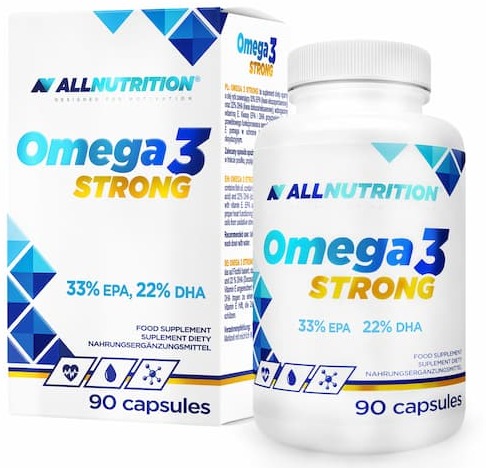
- Content omega-3 acids: 550 mg (DHA 220 mg + EPA 330 mg)
- Additional active ingredients: vitamin E
- Form: capsules .
- Dose: 1 capsule per day .
- Sufficient for: 90 days .
Product description
A dietary supplement with a solid portion of DHA and EPA – valuable for health and well-being omega-3 acidsós. Indicated especially for people on a plant-based diet, physically active people and seniors.
.The sourceóof omega-3 acids in this preparation is fish oil.
.Pros and cons
A dietary supplement with a solid portion of DHA and EPA – valuable for health and well-being omega-3 acidsós. Indicated especially for people on a plant-based diet, physically active people and seniors.
.The sourceóof omega-3 acids in this preparation is fish oil.
.Additional information
A dietary supplement with a solid portion of DHA and EPA – valuable for health and well-being omega-3 acidsós. Indicated especially for people on a plant-based diet, physically active people and seniors.
.The sourceóof omega-3 acids in this preparation is fish oil.
.User review
A dietary supplement with a solid portion of DHA and EPA – valuable for health and well-being omega-3 acidsós. Indicated especially for people on a plant-based diet, physically active people and seniors.
.The sourceóof omega-3 acids in this preparation is fish oil.
.Solgar Omega 3-6-9
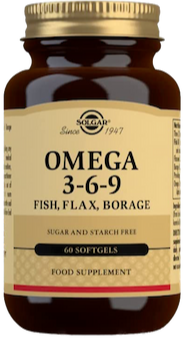
- Content of omega acids:.
- Omega-3 fatty acids.
- Omega-3 fatty acids
- alpha-linolenic acid (ALA) – 585 mg
.- eicosapentaenoic acid (EPA) – 344 mg
- docosahexaenoic acid (DHA) – 221 mg
.
- Omega-3 fatty acids
- Omega-6 fatty acids.
- linoleic acid (LA) – 598 mg .
- gamma-linolenic acid (GLA) – 274 mg .
- Omega-9 fatty acids.
- Oleic acid – 325 mg .
- Omega-3 fatty acids.
- Source of omega acids: fish oil from anchovies, mackerel, sardines, linseed oil, cucumber oil .
- Form: capsules .
- Packaging: 60 capsules .
- Daily allowance:3 capsules per day .
- Sufficient for: 20 days .
Product description
A combination of omega 3-6-9 fatty acidsós derived from fish and plants. The dietary supplement supplements essential omega fatty acids, whichóre needed for the proper functioning of many systemsóorgansóin the body.
Pros and cons
A combination of omega 3-6-9 fatty acidsós derived from fish and plants. The dietary supplement supplements essential omega fatty acids, whichóre needed for the proper functioning of many systemsóorgansóin the body.
Additional information
A combination of omega 3-6-9 fatty acidsós derived from fish and plants. The dietary supplement supplements essential omega fatty acids, whichóre needed for the proper functioning of many systemsóorgansóin the body.
A combination of omega 3-6-9 fatty acidsós derived from fish and plants. The dietary supplement supplements essential omega fatty acids, whichóre needed for the proper functioning of many systemsóorgansóin the body.
Omega + Vitamin D3 800 IU for children
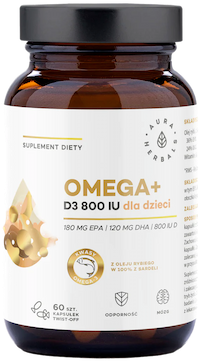
- Content of omega-3 fatty acids: 300 mg (180 mg EPA + 120 mg DHA)
- .
- Additional active ingredients: vitamin D3
- Form: twist-off capsules
- .
- Dose: 1 capsule per day
- .
- Sufficient for: 60 days
- .
Product description
Omega-3 acids for children with added vitamin D3 in good doses. The formula fills the daily requirement of EPA and DHA and vitamin D for children aged 2–18 years.
The Ministry of Health recommends supplementation with vitamin D3. In turn, omega-3 fatty acids are also crucial for the youngest.
The dietary supplement from Aura Herbals supports mós brain function, proper vision and immune system function.
The omega-3 fatty acids are derived from fish oil sourced from anchovies.
Pros and cons
Omega-3 acids for children with added vitamin D3 in good doses. The formula fills the daily requirement of EPA and DHA and vitamin D for children aged 2–18 years.
The Ministry of Health recommends supplementation with vitamin D3. In turn, omega-3 fatty acids are also crucial for the youngest.
The dietary supplement from Aura Herbals supports mós brain function, proper vision and immune system function.
The omega-3 fatty acids are derived from fish oil sourced from anchovies.
Additional information
Omega-3 acids for children with added vitamin D3 in good doses. The formula fills the daily requirement of EPA and DHA and vitamin D for children aged 2–18 years.
The Ministry of Health recommends supplementation with vitamin D3. In turn, omega-3 fatty acids are also crucial for the youngest.
The dietary supplement from Aura Herbals supports mós brain function, proper vision and immune system function.
The omega-3 fatty acids are derived from fish oil sourced from anchovies.
User review
Omega-3 acids for children with added vitamin D3 in good doses. The formula fills the daily requirement of EPA and DHA and vitamin D for children aged 2–18 years.
The Ministry of Health recommends supplementation with vitamin D3. In turn, omega-3 fatty acids are also crucial for the youngest.
The dietary supplement from Aura Herbals supports mós brain function, proper vision and immune system function.
The omega-3 fatty acids are derived from fish oil sourced from anchovies.
Forms of omega-3 in dietary supplements
The most important omega-3 fatty acids, namely eicosapentaenoic acid (EPA) and docosahexaenoic acid (DHA), you can consume from a diet rich in oily marine fish and from dietary supplements in the form of capsules or liquidsand.
The most common forms of omega-3 found in dietary supplements are triglycerides (TG) and esters ethyl (EE). They have a different structure, differ in their production process and how they are metabolised in the body. Many scientists also point to the different degree of their absorption into the bloodstreamand.
I could summarise straight away that triglycerides are better and close the topic. However, I invite you to join me for an enjoyable (yes, it can be done!) lesson in chemistry.
I promise.
I promise you will understand why it is worth choosing triglycerides of omega-3 fatty acids, not because the marketing suggests so, and such are the research findings. This knowledge will help you to consciously choose the best omega-3 supplement.
We roll up our sleeves with pharmacist Ilona Krzak and go with the theme.
Triglycerides of omega-3 acids
Triglycerides are natural forms of omega-3 fatty acids found in fish. TG content and composition depend on the species of fish and the latitude in which they live. Marine animals obtain TGs from phytoplankton (which has the ability to biosynthesise EPA and DHA) and store them in their bodiesand.
When you eat fish rich in omega-3 fatty acids, more than 98% of all fats consumed are in the form of triglycerides . In the production of TG supplements, fatty acids are typically either sourced directly from a natural source or re-esterified into the triglyceride form after purification to increase their quality .
What is natural, so to speak, "closer" to man, will be better absorbed by his body.

Ilona Krzak Master of Pharmacy
Ethyl esters of omega-3 fatty acids
Ethyl esters (EEs) are a synthetic form of omega-3 fatty acids. EEs are artificially created in the laboratory by breaking the bond between the fatty acids and their glycerol skeletonand. It is the only synthetic chemical form of omega-3 polyunsaturated fatty acids approved for the pharmaceutical market since 2006 .
There is a 'something for something' when it comes to omega-3 ethyl esters. They are more durable and resistant, but less well absorbed.

Ilona Krzak Master of Pharmacy
Triglycerides - what are they?
Do you shudder when the chemical talk starts? Rest assured - pharmacist Ilona Krzak explains in simple terms what the omega-3 form of triglycerides is all about:
Triglycerides are a combination of glycerol and ester-like fatty acids. We can visualise the triglyceride molecule in a simple way: a glycerol is a mum with three hands (every mum's dream, an extra pair of hands). With each hand she holds one baby, which is the rest of the fatty acid.
With the right conditions (e.g. catalysts - it's like if we threw a ball to the kids) the fatty acids will diverge and mix, grab the mum (glycerol) with another hand, or play a prank and... go to another mum.
The result of this 'reshuffle' will be that one mum will have three cuddly, another three peaceful children, a third will have children with different names running to her, and a fourth will have three toddlers with the same name.
And this last variant is the trait we need -three of the same fatty acids, because it is the reesterification process where we get the triglycerides we want: with the right consistency and a specific composition.
The ideal, fat family.
Usability and bioavailability of the triglyceride form
Triglycerides may be better absorbed into the bloodstream than ethyl esters. This is supported by: several reasons:
- Natural form. Triglycerides are the natural form of fatty acids in most foods and tissues of human and animal organisms. The body is evolutionarily better adapted to process and absorb fatty acids in the form of triglycerides because they have been present in the natural diet for millions of yearsand.
- Metabolism. Due to their different chemical structure, TGs are subject to less complex absorption processes than EE. Metabolism of triglycerides is more efficientand.
- Pancreatic lipase. TGs are digested by pancreatic lipase, which is a natural process for 'processing' fats, while EEs undergo ester hydrolysis with water. Under the influence of lipase, the fats emulsify, making them more 'available' to the bodyand.
Magister of pharmacy adds:
Triglycerides are better absorbed into the bloodstream, and this is due to their metabolism. TGs in the intestine are 'built up' into micelles formed from bile salts. They create 'globules' that dissolve better and it is easier for lipase to act.
Lipase is an enzyme that is responsible for accelerating the digestion of fats in the body. It works by breaking down triglycerides into glycerol and fatty acids, allowing the body to absorb and utilise nutrients.
Lipase works by breaking down triglycerides into glycerol and fatty acids, allowing the body to absorb and utilise nutrients.
The aforementioned micelles are clusters with the glycerol part inside and the ester part with the fatty acid residue outside. Imagine women in a marketplace. They are standing in a circle, gossiping, with nets full of eggs behind them. Unattended eggs are easy to steal. The thief (lipase) takes one at a time, because it's easier to take them one at a time than a whole net; it goes slower but more efficiently, because the thief also has limited strength.
Lipase - i.e. the thief - has become more familiar with methods to rob (i.e. absorb) triglycerides than with ethyl esters.
Form matters
Natural triglycerides contain three fatty acids attached to the glycerol skeleton, including two major acids - EPA and DHA.
The glycerol skeleton helps to stabilise fat molecules and prevent them from breaking down and oxidising, which prolongs their properties.
During the production of the supplement, the raw material (crude fish oil) is purified and ready for further distribution (e.g. into capsules).
Ethyl esters of omega-3 fatty acids are artificially created in the laboratory by breaking the bond between the fatty acids and their glycerol backbone. "Mom" is disconnected from the babies and each is given to a neighbour (alcohol) The individual fatty acid is then attached to an ethanol molecule in a transesterification process, which is necessary to obtain concentrated and pure fish oil.
And here is the important point: EE concentrate can be converted back into the natural form of triglycerides, which would have a higher bioavailability. But most manufacturers do not do this. It is a time-consuming and expensive process - increasing raw material costs by around 40%and.
This is why the dietary supplement market is full of omega-3 in the form of cheaper ethyl esters, instead of triglycerides.
Dietitian Julia Skrajda adds:
Supplements with EE can be of high quality. Studies show that if the transesterification process has been done correctly, it is not possible to observe big differences in the effects of TG supplementation as well as EE. But unfortunately, most manufacturers do not indicate exactly what the process of obtaining EE was, hence there may be doubts about their quality.

Julia SkrajdaDietitian
You can improve the absorption of ethyl esters of omega-3 fatty acids by taking them with a meal rich in healthy fats.

Ilona Krzak Master of Pharmacy
Scientific research on triglyceride bioavailability
Many scientific studies have compared the bioavailability of different forms of omega-3 fatty acids and several have identified TG as the favorite with the highest bioavailabilityand.
It's worth mentioning why these studies are there - it's not just about what might convince a consumer more to buy a dietary supplement. It is well known, everyone wants to buy the most effective and best preparation.
It is also about investigating the effects of omega-3 on the treatment of various diseases or deficiencies and the official recommendations as to their use. The authors of one meta-analysis point out that depending on the form of omega-3 fatty acids used in different studies, the results are contradictory and researchers may draw erroneous conclusionsand.
Several studies have examined whether omega-3 supplementation can affect cardiovascular health. However, in each study, DHA and EPA were in different forms and were not always consumed in the presence of a fatty meal, which increases omega-3 uptake.
There is a lack standardisation of studies and they are variable in quality. Therefore, to be fair, I found several papers by researchers that compared the bioavailability of different forms of omega-3 fatty acids in a similar way.
Review of 2013 studies (USA)
The authors reviewed and compared the results of 18 scientific studies on the bioavailability of different forms of omega-3 fatty acids (mainly triglycerides, ethyl esters, free fatty acids, cod-liver oil, krill oil). The results of 8 studies strongly indicated that the triglyceride form is better bioavailable than ethyl esters, and in 4 of these studies the results suggest that their bioavailability is similarand.
Of note, free fatty acids (FFAs, Free Fatty Acids) were found to be the winner in bioavailability in single studiesand.
Free fatty acids will be absorbed faster because they do not need to be hydrolysed. However, if there are no monoacylglycerols to facilitate absorption, they will have nothing to re-esterify with. For this reason, it is the triglycerides that win out.

Ilona Krzak Master of Pharmacy
Study from 2010 (Germany)
Participants (150 people) selected for the study had to meet strict criteria, including being on a fish-free diet, having no diagnosed specific diseases or having an adequate BMI - anything that could potentially have distorted the resultsand.
The subjects were divided into three groups, which took:
- fish oil concentrate with EPA + DHA in the form of triglycerides,
- fish oil concentrate with EPA + DHA in the form of ethyl esters,
- corn oil - placebo,
The volunteers consumed four gelatine capsules daily for six months. The results showed that blood levels of omega-3s increased in both groups taking EPA+DHA, and in the group that took the TG capsules, the increase was up to 25% higher than in those who took EE.
That is, omega-3 fatty acid supplementation makes sense, and with TG it is even more effective.
Study from 2010 (Denmark)
Danish researchers tested the bioavailability of triglycerides (TG), ethyl esters (EE) and free fatty acids (FAA) compared to natural fish oiland.
Seventy-two subjects of both sexes were selected for the study and had to meet certain criteria, such as not drinking alcohol before the study and not supplementing with DHA and EPA. The subjects were divided into six groups, in which they took either a placebo or concentrated fish oil at different doses (average 3 g).
The study was divided into six groups, in which they took either a placebo or concentrated fish oil at different doses (average 3 g).
After 2 weeks, the results showed that in those taking 'real' DHA and EPA, blood concentrations of these acids increased, indicating that supplementation of either form made up for their deficiencies due to diet.
In addition, the researchers calculated that:
- TGs have a higher bioavailability than ethyl esters, increasing EPA and DHA concentrations up to 51% better than EE,
- The bioavailability of EPA+DHA from re-esterified triglycerides was better (124%) compared to natural fish oil (100%), whereas bioavailability from ethyl esters was worse (73%),
- The bioavailability of free fatty acids (91%) was not significantly different from that of natural triglycerides.
Furthermore, after accounting for dosage in subjects, the average relative bioavailability was 76% with EE, 86% with FFA and 134% with rTG.
Expert comment
The studies suggest that dietary supplements with omega-3 fatty acids in both triglyceride and ethyl ester forms can supplement healthy dietary fats. In several of these, it is the TGs that have the advantage, which seems logical - after all, it is the natural form, better metabolised and ultimately more efficiently absorbed into the bloodstream.
It pays ... to pay extra?
Dietary supplements with omega-3 fatty acids in the form of triglycerides can supplement healthy fats in your diet more quickly and effectively, but are more expensive. All in all, ethyl esters are not bad, they do work after all, but... well, is it worth paying more for TG?
Yes, you already know the scientific results. Let's assume that you want to take the recommended 250 mg of EPA + DHA acids per day for Poles from a dietary supplement. If you apply the absorption statistics presented earlier, you will "benefit" from 134% bioavailability from fish oil in the TG form and 76% bioavailability from fish oil in the EE form.
In other words - fish oil with TG has 1.7 times higher bioavailability than fish oil with EE. So by taking a capsule of EE with a 250 mg serving, you'll probably only absorb 190 mg of omega-3 fatty acids. Ok, this you know, so you could take one more capsule or a sip of liquid, but... what's the point? It's not worth it.
So yes, it is worth paying extra for a dietary supplement with TG, especially if you are deficient in omega-3 fatty acids.
Triglycerides vs ethyl esters - a comparison
Triglycerides and ethyl esters are the two most common forms of omega-3 fatty acids in dietary supplements. Let's summarise our knowledge of them in a table to organise the information and make it easier for you to choose.
Natural, found in the bodies of humans and animals.
The hydrolysis process is less efficient.
TG supplementation is effective in correcting omega-3 deficiencies in the body.
|
Trait |
Triglycerides |
Ethyl esters |
||
|
Form |
Natural, found in human and animal organisms. Natural. |
Synthetic, created in the laboratory. |
||
|
Structure |
Fatty acid combined with glycerol. Fatty acid combined with glycerol. |
Fatty acid combined with ethanol. |
Fatty acid combined with ethanol. |
|
|
Usability |
High |
Good, provided fat is supplied with food. Good. |
||
|
Bioavailability |
High |
Good. |
Good. |
|
|
Metabolism after ingestion |
The digestion and absorption process is less complex and more efficient than EE. |
Because of the different structure and stronger chemical bonding of ethanol to fatty acid residues, the hydrolysis process occurs less efficiently. |
||
|
Solubility |
Weak in water - emulsification with bile acid salts is necessary. |
Weak in water - emulsification with bile acid salts is necessary. |
In water weak - emulsification with bile acid salts necessary. |
In water weak - emulsification with bile acid salts necessary. |
|
Production costs |
High |
Low. |
||
|
Price of raw material |
High (from tens to hundreds of zlotys). |
High. |
Low to medium (from a dozen to several tens of zlotys). |
High (from a dozen to several hundred zlotys). |
|
Permanence |
Average |
High. |
||
|
Scientific research |
Some studies suggest that the TG form may be up to several times better bioavailable than EE. TG supplementation is effective in correcting omega-3 deficiencies in the body. |
Research suggests that EEs are well absorbed and supplement EPA and DHA deficiencies in the body, and are best when taken in the presence of a fatty meal. |
. |
Expert comment
Several reliable studies suggest that fatty acids in the form of triglycerides have a higher bioavailability and are better absorbed into the bloodstream. If you are concerned about supplementing DHA and EPA in your diet, it is worth choosing the triglyceride form.
How to find out what form a dietary supplement is in?
The rule of thumb is simple - if a supplement contains omega-3 fatty acids in the form of triglycerides, you will definitely find information about this on the packaging. Why? The manufacturers have also read the research and added more money to the production of their supplement, so they are happy to show off this form.
If the product is an ethyl ester, this may also be written on the packaging or on the manufacturer's website. Are you looking and cannot find the information either on the bottle or on the website in question? This means that the product is an ethyl ester.
How much omega-3 do I need?
The current Nutrition Standards recommendations for Poles indicate minimum amounts of omega-3 fatty acids in your diet on a daily basisand. Check how much your dietary supplement provides (and in what form) or whether you are eating enough oily fish (around 300g per week).
|
Group |
Recommended intake of EPA+DHA |
|
Adults |
250 mg |
|
Pregnant and breastfeeding women |
|
| . |
250 mg/day and additionally 100-200 mg DHA/day |
|
Infants, children and adolescents up to 18 years of age |
|
| . |
7-24 months: DHA 100 mg/day only; 2-18 years: EPA+DHA 250 mg/day |
See also:
How to naturally increase the uptake of omega-3 fatty acids?
Whether you choose TG or EE, you can further increase the bioavailability of DHA and EPA. How can you do this?
Like fats
Drink a supplement with omega-3 fatty acids in the presence of a meal with healthy fats - this will increase their bioavailabilityand. What products can you choose from?
Omega-3 fatty acids will thrive better in the presence ofand:
- avocado,
- olive oil,
- oils (e.g. linseed)
- veggies,
- nuts, seeds and stones,
- flaxseed,
- soy,
- fatty fish (e.g. Norwegian salmon),
One study compared the bioavailability of TG and EE in a meal containing 8 g and 44 g of fat. The high-fat food increased the uptake of EPA from TG by 21%, and EPA and DHA from EE by 40%. It is also worth noting that the bioavailability of triglycerides in the low-fat meal was higher than that of ethyl esters by approximately 40%and.
Reasonably with coffee
Coffee is healthy and worth drinking - this is undeniable. However, drinking coffee can interfere with the absorption of nutrientsand. Therefore, it is worth following a simple rule of thumb - at least one hour before taking a supplement and one hour after, do not drink coffee.
This will ensure that you do not interfere with the absorption of not only omega-3 acids, but also other vitamins and minerals, such as iron, B vitamins or magnesiumand.
Store wisely
Omega-3 fatty acids are prone to oxidation, i.e. losing their propertiesand. It is a good idea to store the dietary supplement in a cool and dark place. A lockable cupboard is ideal, but away from the microwave, oven or heater.
Take care of your bowels
Proper digestion and absorption of nutrients depends on the health of your digestive system. Conditions such as coeliac disease and Crohn's disease can damage the intestinal lining and impair nutrient absorptionand.
For reduced absorption of important vitamins, minerals and omega acids is also affected by infection Helicobacter Pylori, small intestinal bacterial overgrowth syndrome (SIBO) or excessive alcohol consumptionand.
If you are experiencing gastrointestinal complaints, see your doctor. Pain and discomfort is something you feel temporarily, but when nutrient deficiencies occur - it's a delayed bomb.

Sprawdź, za co pokochały go tysiące klientek Natu.Care Premium Omega-3ᵀᴳ -15% z kodem BLOG15
Natu.Care Omega-3ᵀᴳ Premium
Natu.Care Omega-3ᵀᴳ Premium dla zdrowia serca, mózgu i odporności. Najlepsza przyswajalność. Optymalna dawka 750 mg. Przebadana przez niezależne laboratorium.
Zobacz więcej
Produkt ma super skład, transparentną etykietę i co dla mnie jest ważne – małe kapsułki do połknięcia. Nie ma też nieprzyjemnego efektu odbijania rybą, który miałam spożywając inne produkty. Widzę znaczną poprawę odporności. Polecam!@Kasia P.
See also:
- Best sources of omega-3 in the diet
- Omega medicine, not a supplement
- Omega-3 for athletes
- Omega-3 for children. Which ones to choose?
Summary
- To supply your body with omega-3 fatty acids you need to eat around 300g of oily fish per week.
- If you do not eat fish, consider supplementation. To effectively supplement DHA and EPA acids (250 mg per day), pay attention to the bioavailability of the dietary supplement.
- The most common forms of omega-3 fatty acids in dietary supplements are triglycerides (TG) and ethyl esters (EE).
- TGs are the natural form found in organisms, while EEs are the synthetic form created in the laboratory.
- Triglycerides and ethyl esters are the most common forms of omega-3.
- According to several scientific studies, the triglyceride form has up to twice the bioavailability as ethyl esters.
- It is worth taking omega-3 fatty acids in the presence of healthy fats such as avocados, nuts, seeds, oils or olive oil, which increases the absorption of DHA and EPA in the body.
FAQ
Omega-3 fatty acids - which ones to choose?
Recommended omega-3 acids DHA+EPA with a good formulation is Natu.Care Omega-3 ᵀᴳ Premium with a 500 mg EPA acid and 250 mg DHA acid. Taking 1 capsule a day supplements the diet with valuable fats and the pack lasts for 60 days of supplementation. The supplement has laboratory tests to confirm the purity of the composition ( e.g. for bacteria E. Coli).
Who should supplement EPA+DHA?
Acids omega-3 (EPA+DHA) are recommended for supplementation:
- vegans and vegetarians,
- persons consuming low-fat fish,
- children during periods of intensive growth,
- seniors,
- patients receiving cardiac treatment and prevention of heart disease,
- people with autoimmune diseases, e.g. psoriasis, rheumatoid arthritis (RA), Hashimoto's disease,
- allergic people,
- physically active people, athletes.
What are the best EPA+DHA acids?
The best EPA+DHA acids can be found in dietary supplements with omega-3 acids in the form of triglycerides. This form is absorbed up to 1.7 times better than the popular esters on the supplement market. A recommended preparation with triglycerides is Natu.Care Omega-3 TG with 750 mg EPA+DHA in 1 daily serving.
What is an omega-3 drug, not a supplement?
Omega-3 in drug form is found in Omacor. This is a prescription-only drug that contains 1000 mg of DHA + EPA acids in the form of triglycerides in capsules. It is only prescribed in specific cases.
For children, it is best to choose omega-3 acids that are easy to take (e.g. twist-off capsules, easy to swallow or soft gel) and contain approximately 250 mg EPA+DHA per daily dose. For children, the product Aura Herbals Omega + D3 for Children is recommended. It is suitable from the age of 1 year.
Are triglycerides and reesterified triglycerides the same thing?
Magister of Pharmacy explains: yes, chemically they are one and the same. However, these re-esterified triglycerides are "tailor-made" because in the re-esterification process we can improve something, improve something in these triglycerides, such as consistency or content of specific fatty acids.
Is bioavailability the same as bioavailability?
No, bioavailability and bioavailability are different concepts. Bioavailability refers to the absorption and utilisation of nutrients by the body, whereas bioavailability considers both the bioavailability and the efficiency of nutrient utilisation. Bioavailability is therefore a broader term that includes assimilability.
What time to take omega-3 fatty acids?
The time of intake of omega-3 fatty acids does not matter, but the presence of fats when consumed is important to ensure the best absorption into the bloodstream. Supplement omega-3 acids with healthy fats such as avocados, nuts, canola oil, olive oil.
How long can omega-3 acids be used?
If your diet lacks healthy fats and you do not eat about 300 g of oily fish per week, you can use omega-3 acids from dietary supplements all year round. Supplementation with omega-3 acids should be tailored to your individual needs, diet and lifestyle.
Sources
See all
Alhomsi, K., Cluette-Brown, J. E., & Laposata, M. (2006). Fatty acid ethyl esters in human mononuclear cells: Production by endogenous synthesis greatly exceeds the uptake of preformed ethyl esters. Alcoholism, Clinical and Experimental Research, 30(3), 560-566. https://doi.org/10.1111/j.1530-0277.2006.00062.x
Backes, J., Anzalone, D., Hilleman, D., & Catini, J. (2016). The clinical relevance of omega-3 fatty acids in the management of hypertriglyceridemia. Lipids in Health and Disease, 15(1), 118. https://doi.org/10.1186/s12944-016-0286-4
Beckermann, B., Beneke, M., & Seitz, I. (1990). [Comparative bioavailability of eicosapentaenoic acid and docasahexaenoic acid from triglycerides, free fatty acids and ethyl esters in volunteers]. Arzneimittel-Forschung, 40(6), 700-704.
Bryhn, M., Hansteen, H., Schanche, T., & Aakre, S. E. (2006). The bioavailability and pharmacodynamics of different concentrations of omega-3 acid ethyl esters. Prostaglandins, Leukotrienes, and Essential Fatty Acids, 75(1), 19-24. https://doi.org/10.1016/j.plefa.2006.04.003
Davidson, M. H., Johnson, J., Rooney, M. W., Kyle, M. L., & Kling, D. F. (2012). A novel omega-3 free fatty acid formulation has dramatically improved bioavailability during a low-fat diet compared with omega-3-acid ethyl esters: the ECLIPSE (Epanova(®) compared to Lovaza(®) in a pharmacokinetic single-dose evaluation) study. Journal of Clinical Lipidology, 6(6), 573-584. https://doi.org/10.1016/j.jacl.2012.01.002
Davidson, M. H., Kling, D., & Maki, K. C. (2011). Novel developments in omega-3 fatty acid-based strategies. Current Opinion in Lipidology, 22(6), 437-444. https://doi.org/10.1097/MOL.0b013e32834bd642
Dyerberg, J., Madsen, P., Møller, J. M., Aardestrup, I., & Schmidt, E. B. (2010). Bioavailability of marine n-3 fatty acid formulations. Prostaglandins, Leukotrienes, and Essential Fatty Acids, 83(3), 137-141. https://doi.org/10.1016/j.plefa.2010.06.007
EFSA assesses safety of long-chain omega-3 fatty acids | EFSA. (2012, July 27). https://www.efsa.europa.eu/en/press/news/120727
Lawson, L. D., & Hughes, B. G. (1988a). Absorption of eicosapentaenoic acid and docosahexaenoic acid from fish oil triacylglycerols or fish oil ethyl esters co-ingested with a high-fat meal. Biochemical and Biophysical Research Communications, 156(2), 960-963. https://doi.org/10.1016/s0006-291x(88)80937-9
Lawson, L. D., & Hughes, B. G. (1988b). Human absorption of fish oil fatty acids as triacylglycerols, free acids, or ethyl esters. Biochemical and Biophysical Research Communications, 152(1), 328-335. https://doi.org/10.1016/s0006-291x(88)80718-6
Neubronner, J., Schuchardt, J. P., Kressel, G., Merkel, M., von Schacky, C., & Hahn, A. (2011). Enhanced increase of omega-3 index in response to long-term n-3 fatty acid supplementation from triacylglycerides versus ethyl esters. European Journal of Clinical Nutrition, 65(2), Article 2. https://doi.org/10.1038/ejcn.2010.239
Nutrition, C. for F. S. and A. (2020a). FDA Announces New Qualified Health Claims for EPA and DHA Omega-3 Consumption and the Risk of Hypertension and Coronary Heart Disease. FDA. https://www.fda.gov/food/cfsan-constituent-updates/fda-announces-new-qualified-health-claims-epa-and-dha-omega-3-consumption-and-risk-hypertension-and
Nutrition, C. for F. S. and A. (2020b). FDA Announces New Qualified Health Claims for EPA and DHA Omega-3 Consumption and the Risk of Hypertension and Coronary Heart Disease. FDA. https://www.fda.gov/food/cfsan-constituent-updates/fda-announces-new-qualified-health-claims-epa-and-dha-omega-3-consumption-and-risk-hypertension-and
Office of Dietary Supplements-Omega-3 Fatty Acids. (n.d.). Retrieved 16 October 2023, from https://ods.od.nih.gov/factsheets/Omega3FattyAcids-HealthProfessional/?utm_source=pocket_saves
Poole, R., Kennedy, O. J., Roderick, P., Fallowfield, J. A., Hayes, P. C., & Parkes, J. (2017). Coffee consumption and health: Umbrella review of meta-analyses of multiple health outcomes. The BMJ, 359, j5024. https://doi.org/10.1136/bmj.j5024
Schuchardt, J. P., & Hahn, A. (2013). Bioavailability of long-chain omega-3 fatty acids. Prostaglandins, Leukotrienes, and Essential Fatty Acids, 89(1), 1-8. https://doi.org/10.1016/j.plefa.2013.03.010
Vandal, M., Freemantle, E., Tremblay-Mercier, J., Plourde, M., Fortier, M., Bruneau, J., Gagnon, J., Bégin, M., & Cunnane, S. C. (2008). Plasma Omega-3 Fatty Acid Response to a Fish Oil Supplement in the Healthy Elderly. Lipids, 43(11), 1085-1089. https://doi.org/10.1007/s11745-008-3232-z
Visioli, F., Risé, P., Barassi, M. C., Marangoni, F., & Galli, C. (2003). Dietary intake of fish vs. Formulations leads to higher plasma concentrations of n-3 fatty acids. Lipids, 38(4), 415-418. https://doi.org/10.1007/s11745-003-1077-x
von Schacky, C. (2006). A review of omega-3 ethyl esters for cardiovascular prevention and treatment of increased blood triglyceride levels. Vascular Health and Risk Management, 2(3), 251-262. https://doi.org/10.2147/vhrm.2006.2.3.251
von Schacky, C. (2014). Omega-3 index and cardiovascular health. Nutrients, 6(2), 799-814. https://doi.org/10.3390/nu6020799
Walker, R. E., Jackson, K. H., Tintle, N. L., Shearer, G. C., Bernasconi, A., Masson, S., Latini, R., Heydari, B., Kwong, R. Y., Flock, M., Kris-Etherton, P. M., Hedengran, A., Carney, R. M., Skulas-Ray, A., Gidding, S. S., Dewell, A., Gardner, C. D., Grenon, S. M., Sarter, B., ... Harris, W. S. (2019). Predicting the effects of supplemental EPA and DHA on the omega-3 index. The American Journal of Clinical Nutrition, 110(4), 1034-1040. https://doi.org/10.1093/ajcn/nqz161
Yang, L. Y., Kuksis, A., & Myher, J. J. (1990). Lipolysis of menhaden oil triacylglycerols and the corresponding fatty acid alkyl esters by pancreatic lipase in vitro: A reexamination. Journal of Lipid Research, 31(1), 137-147.
Editorials
Meet the team

Ilona Krzak obtained her Master of Pharmacy degree from the Medical University of Wrocław. She did her internship in a hospital pharmacy and in the pharmaceutical industry. She is currently working in the profession and also runs an educational profile on Instagram: @pani_z_apteki


Omega-3 fatty acids are a useful dietary supplement for active people - improves performance and fitness.
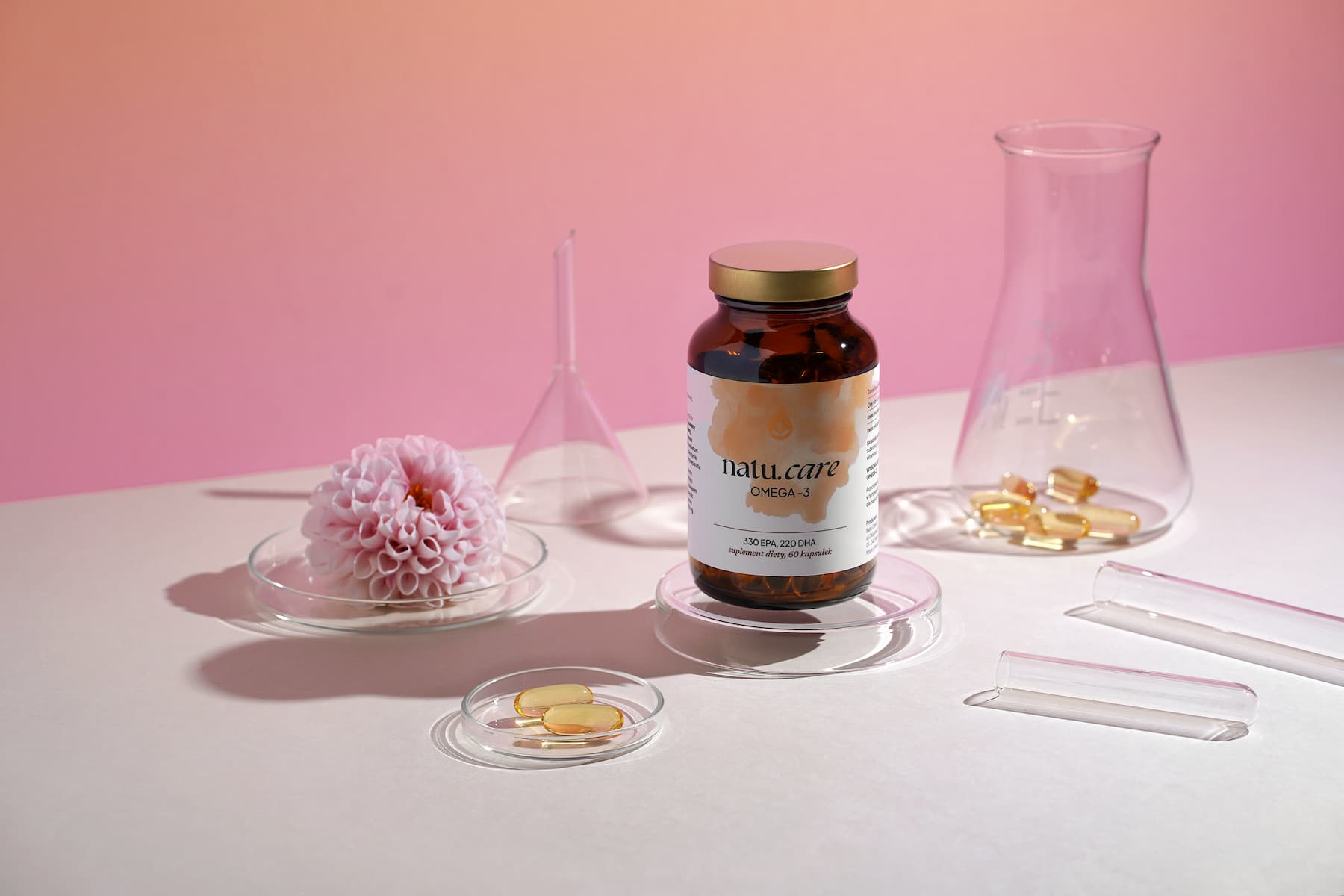
Omega-3 in a good dose and an optimum ratio of DHA and EPA acids will replenish valuable fats in the diet.
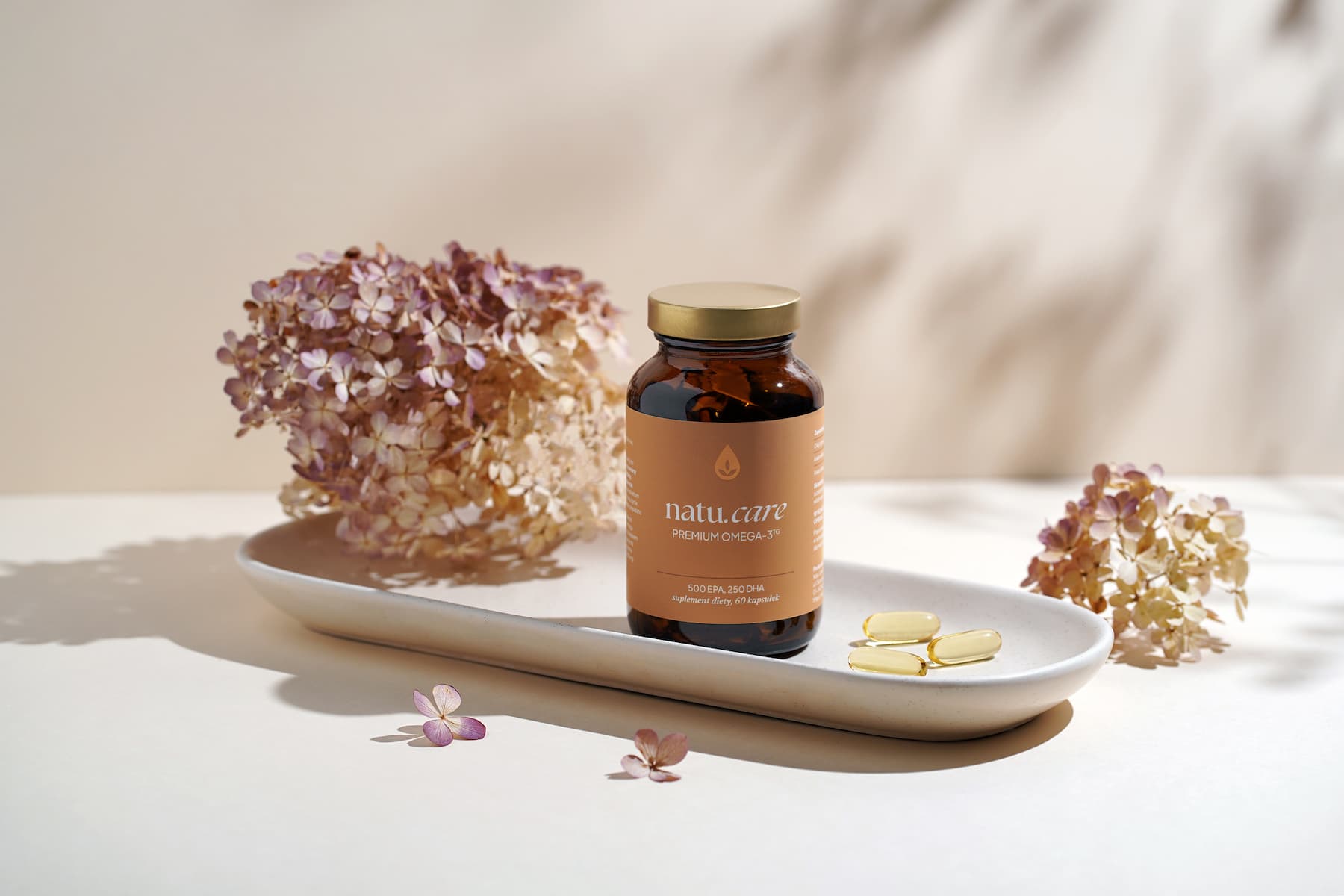
The omega-3 acids from Natu.Care are distinguished by their triglyceride form, which is characterised by high bioavailability.
